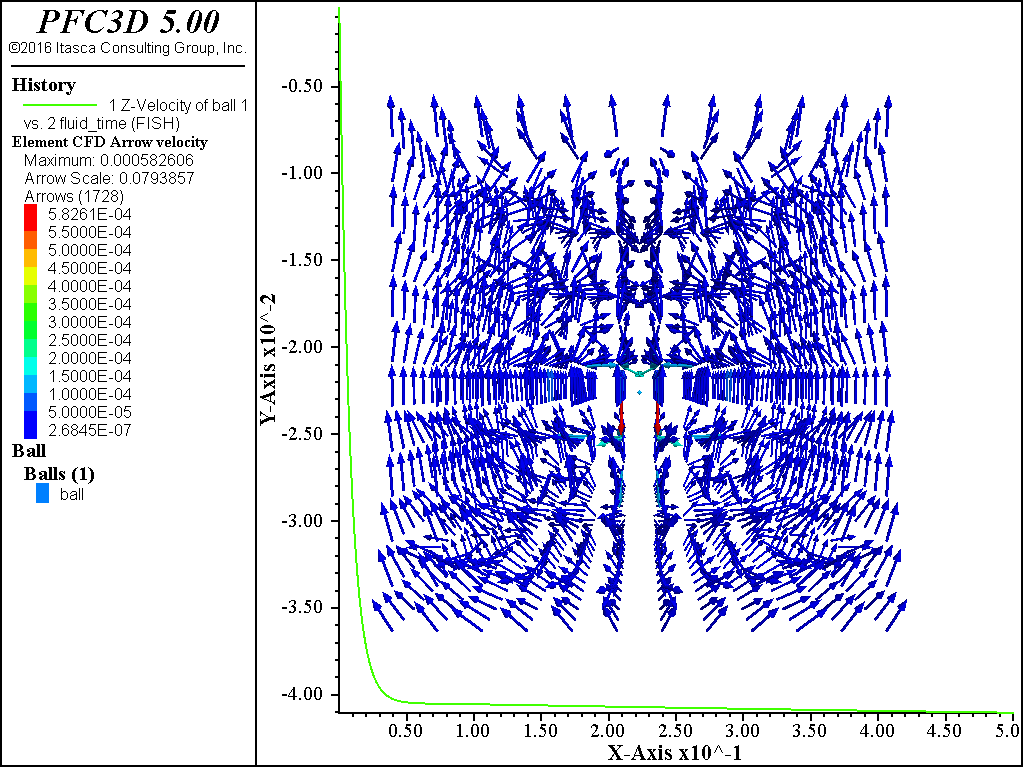The repository contains information about solving fluid-particle interaction problems by coupling OpenFOAM based CFD solvers with PFC3D. OpenFOAM is an open source C++ framework for numerical analysis of continuum mechanics problems. Particle Flow Code in Three Dimensions (PFC3D) is a discrete element code produced by Itasca Consulting Group.
OPENFOAM® is a registered trade mark of OpenCFD Limited, producer and distributor of the OpenFOAM software. This offering is not approved or endorsed by OpenCFD Limited, producer and distributor of the OpenFOAM software and owner of the OPENFOAM® and OpenCFD® trade marks.
Itasca Consulting Group does not provide support for OpenFOAM.
The two-way coarse-grid coupling between PFC3D and OpenFOAM follows the approach of Tsuji. Porosity and body force fields are included in the Navier-Stokes equation to account for the presence of particles in the flow and these terms are linked to drag forces on the PFC3D particles.
A Python module pyDemFoam is included which contains modified
versions of the OpenFOAM icoFoam and simpleFoam solvers. These
solvers are modified to account for the presence of solid particles.
Currently, OpenFOAM only runs on Linux systems and PFC3D only runs
on Windows systems. As a work around OpenFOAM is run inside of a
VirtualBox Ubuntu guest. Python and TCP sockets are used to link
demIcoFoam to PFC3D.
The following diagram gives an overview of the system.
Update to the latest PFC3D version: http://www.itascacg.com
Install VirtualBox 5.0.20 or newer http://download.virtualbox.org/virtualbox/5.0.20/VirtualBox-5.0.20-106931-Win.exe
Install Ubuntu 16.04 into VirtualBox http://www.ubuntu.com/download/desktop
Install the VirtualBox Linux Guest Additions: In the Virtual Box window select Devices > Insert the Guest Additions CD Image. Follow the on screen instructions.
Make sure you Ubuntu environment is current with:
sudo apt-get update
and
sudo apt-get upgrade
sudo apt-get install python-pip emacs24 git gitk build-essential cmake flex bison zlib1g-dev qt4-dev-tools libqt4-dev libqtwebkit-dev gnuplot libreadline-dev libncurses5-dev libxt-dev libopenmpi-dev openmpi-bin libboost-system-dev libboost-thread-dev libgmp-dev libmpfr-dev python python-dev libcgal-dev python-numpy ipython python-scipy cythonInstall the itasca Python module with pip install itasca
What follows here is a distillation of the instructions from here:
https://openfoamwiki.net/index.php/Installation/Linux/OpenFOAM%2B-3.0%2B/Ubuntu
consult this link if you have problems.
First, download and unzip OpenFOAM v3.0+ and the third party dependencies with the following commands.
cd ~
mkdir OpenFOAM
cd OpenFOAM
wget "http://downloads.sourceforge.net/openfoamplus/files/OpenFOAM-v3.0%2B.tgz?use_mirror=mesh" -O OpenFOAM-v3.0+.tgz
wget "http://downloads.sourceforge.net/openfoamplus/files/ThirdParty-v3.0%2B.tgz?use_mirror=mesh" -O ThirdParty-v3.0+.tgz
tar -xzf OpenFOAM-v3.0+.tgz
tar -xzf ThirdParty-v3.0+.tgzAdd the following line to the end of: ~/.bashrc
source $HOME/OpenFOAM/OpenFOAM-v3.0+/etc/bashrc WM_NCOMPPROCS=4 WM_MPLIB=SYSTEMOPENMPI
To load these changes:
source ~/.bashrc
ParaView is a post-processing program which can be used to visualize
OpenFOAM results. It it typically used via the paraFoam wrapper.
cd $WM_THIRD_PARTY_DIR
export QT_SELECT=qt4
./Allwmake > log.make 2>&1
wmSET $FOAM_SETTINGS
./makeParaView4 -python -mpi -python-lib /usr/lib/x86_64-linux-gnu/libpython2.7.so.1.0 > log.makepv4_2
If you have problems with paraFoam try: export LIBGL_ALWAYS_SOFTWARE=1
wmSET $FOAM_SETTINGS
cd $WM_PROJECT_DIR
export QT_SELECT=qt4
find src applications -name "*.L" -type f | xargs sed -i -e 's=\(YY\_FLEX\_SUBMINOR\_VERSION\)=YY_FLEX_MINOR_VERSION < 6 \&\& \1='
./Allwmake > log.make 2>&1At this point OpenFOAM should be built. Try icoFoam -help to
confirm.
pyDemFoam is a Python module which contains modified versions of
OpenFOAM solvers. It includes porosity and body force terms to
account for the presence of the particles. Modified version of both
icoFoam and simpleFoam are provided.
cd
mkdir src
cd src
git clone https://github.com/jkfurtney/PFC3D_OpenFOAM.git
cd PFC3D_OpenFOAM/pyDemFoam/
python setup.py install --userTest that this worked:
cd ~
python -c "import pyDemFoam; print pyDemFoam.__version__"A version number number like: 2016.06.09 should be shown if the
installation worked correctly.
Under Windows make a clone of this repository.
A demonstration and verification problem is included in the
dropTest1/ folder.
-
Start PFC3D and open
dropTest1/dropTest1.p3prj -
Run the file
pfc_dropTest1.py
cd ~/src/PFC3D_OpenFOAM/dropTest1/
blockMesh
python cfd_dropTest1.pyThis should launch the coupled calculation.
This work is intended as a demonstration of how to connect PFC3D to a CFD solver. The implementation given here is limited in the following ways:
-
No linear relaxation is used to stabilize the equations. Numerical instabilities are likely to occur.
-
No turbulence model is included in the analysis.
-
Time derivatives of porosity are not included in the momentum or continuity equations.
-
Further verification of the coupled system is underway.
Documentation for OpenFOAM can be found here: http://cfd.direct/openfoam/documentation/
If you are exploring the OpenFOAM C++ code it is helpful to have a local copy of the OpenFOAM C++ API documentation. GNU Global can help navigating large source codes.
sudo apt-get install doxygen graphviz global
cd $WM_PROJECT_DIR/doc
./AllwmakeThe Doxygen reference should be in $WM_PROJECT_DIR/doc/Doxygen/html/index.html
python setup.py install --user > log.txt 2>&1 && tail log.txt
-
OpenFOAM LAMMPS coupling: https://github.com/xiaoh/sediFoam
-
OpenFOAM YADE coupling: http://trace.tennessee.edu/utk_graddiss/21/

